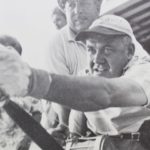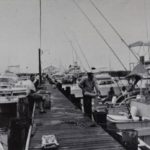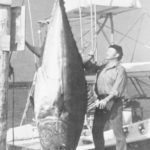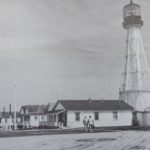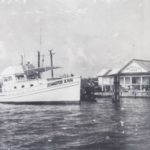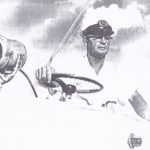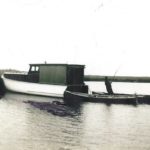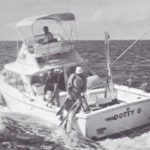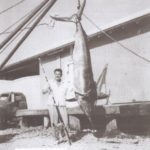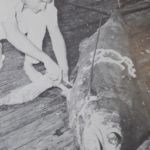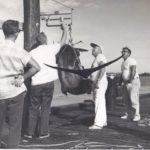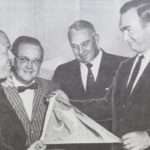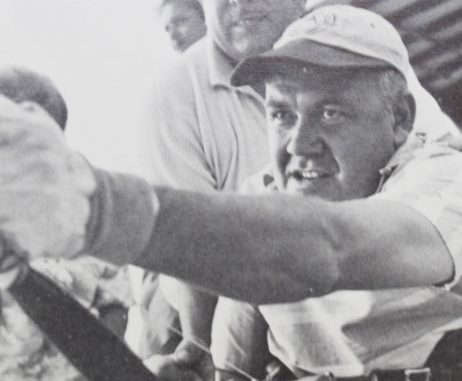
Birthing the New Orleans Big Game Fishing Club wasn’t a whim — it only came about through a lot of work and the dreams of one man convinced that Louisiana offshore waters could be famous.
Louisiana is blessed in all things that come from the water. Its reputation as a seafood-producing and consuming state is unequaled.
The first European explorers of what is now the state were amazed at the quality and quantity of freshwater fish present. Recreational saltwater fishing in Louisiana’s coastal waters, lakes and bays has long been the best in the United States.
Perhaps the abundance of these resources prevented the early development of deep-sea, big-game fishing.
The history of offshore big-game fishing in Louisiana is more than a history of a fishery. It is also the history of one man — Herman “Dutch” Prager — and a club, the New Orleans Big Game Fishing Club.
Into the early 1950s, big-game fishing was an occasional sailfish hauled into Grand Isle. In 1969, Paul Kalman, a pioneering outdoors writer for the New Orleans Item newspaper and avid fisherman, claimed he caught one of the earliest sailfish he could recall from the Flying Dutchman, an old two-masted schooner working in the charter trade.
The tale begins in 1948, when the U.S. Fish & Wildlife Service assigned the research vessel Oregon to the Gulf of Mexico. Fish & Wildlife Service scientist Harvey R. Bullis Jr. was convinced that yellowfin tuna (then often called Allison tuna) occurred in the Gulf in commercial quantities and dispatched the vessel on multiple cruises to find out.
On one of the 1953 cruises, Louisiana Conservationist magazine editor Claude H. “Grits” Gresham hitched a ride to watch the scientists make three longline sets offshore of the Mississippi River delta.
The catch astounded him: 45 yellowfin tuna, two blue marlin, 13 white marlin, one sailfish and three mako sharks, as well as a host of other less game-worthy sharks.
In other trips the crew of the Oregon caught bluefin tuna and swordfish, as well.
Gresham showed his enthusiasm in an article in his magazine.
“The sport fishermen have good reason for high hopes ….” he wrote. “If it is found that we have these big game fish — marlin, tuna, makos, in fishable quantities, and it certainly looks as though we have, Louisiana may become the center of a new and great sport fishing industry. The bigger of the two blue marlin taken on this trip would have ranked second in the country for 1953, had it been taken on sport tackle. Both would have ranked in the top five.
“The fish are there and Louisiana has a strategic position. Our Mississippi Delta gives us protective land extending a hundred miles into the Gulf. It puts us within 10 miles of ‘deep water’ — the 100 fathom line. Let’s take advantage of nature’s gift in this respect. Let’s not miss the boat.”
People listened.
In late 1954, Gresham corresponded with Capt. Bob Mitcheltree, a Grand Isle charter captain, about what he witnessed on the research vessel. In June 1956, Kalman invited Bullis to New Orleans to appear on his Jax Beer Outdoors in Louisiana television show. The “movie footage” he showed hooked Kalman and, in his words, gave him “the cold sweats.”
In a few weeks, Kalman arranged for a three-yacht expedition, with the intended target being marlin and tuna. None of the vessels were equipped with flying bridges, fighting chairs or outriggers.
John Lauricella, Sr., owner of the All American landed a 7 ½-foot white marlin weighing 50 pounds, the first one ever caught by rod and reel off Louisiana.
Kalman, on the yacht Kiwi, followed with another of the same size.
Robert Norman, owner of the Kiwi landed a 70-pound yellowfin tuna, thus becoming the first person to catch an officially identified yellowfin on rod and reel off of Louisiana.
James Meriwether, owner of the yacht Mallou II, and his wife and son landed several bull dolphin, including one going 38 pounds. Meriwether’s big day would come later.
The report on the trip spurred others, including Mitcheltree, who had made two earlier trips out of the Mississippi River’s South Pass. One trip in April produced a blank. On the second trip, in May, he caught a boatload of dolphin.
After the Kalman trip, Mitcheltree returned for a third time. This one produced sailfish, but still no marlin.
But the blue-water bug had bitten the veteran charter captain. Although most of his fishing was still done near Grand Isle, he began taking parties out of South Pass in 1957.
On June 21, 1958, Baton Rouge physician Glenn Gibson fished from Mitcheltree’s Jennifer Ann and boated Louisiana’s first blue marlin — a rather modest 175-pounder.
The trip also produced two white marlin, a sailfish and 25 bull dolphin.
Less than a month later, lightning struck at the Grand Isle Tarpon Rodeo: The Mallou II, Jim Meriwether’s yacht, backed in to the dock, and strapped across the stern was a 465 1/2-pound blue marlin.
The crowd watched in amazement as the behemoth was unloaded. In that crowd stood two men: Herman “Dutch” Prager and his fishing companion Dale Thompson.
The sight changed Prager’s life. He recalled his thoughts to outdoors writer Bob Marshall for a 1989 article in Southern Saltwater Magazine.
“I looked at that fish, and I kept thinking, ‘My goodness, what must it be like to be hooked up to the other end of something like that?’” he said. “Right then and there I was determined to find out; I just had to catch a fish like that.”
Prager had read about blue marlin fishing at the Bimini Big Game Fishing Club, so he and his wife Kay left for the Caribbean island to learn how to marlin fish from experienced marlin fishermen, and actually became members of the club.
But he caught nothing.
Back in Louisiana, other developments were occurring. Mitcheltree had made a change.
“It’s kind of hard,” he confessed to Kalman, “to fish for marlin and tuna, and then go back to trolling for Spanish mackerel. I took it as long as I could. Finally, in May of 1959, I told my wife Jessie I couldn’t stand the strain any longer. I was wearing out both my boat and myself trying to commute all the way from Grand Isle. So we rented out our house on the island, packed our gear aboard the Jennifer Ann, and let down our roots permanently at the mouth of the river.”
Their new home and headquarters was variously described as a “leaky ramshackle lean-to” or a “ramshackle cottage” located next to the Port Eads lighthouse on South Pass.
“I was past 50, and it was a big gamble,” Mitcheltree later admitted, “but I felt that I was making an educated guess. I had fished extensively through the Florida Keys and the Bahamas, and never before had I encountered the concentrations of billfish and tuna that we were seeing off South Pass.”
Their new home base was called “River’s End.” In spite of a lack of fuel, fresh water and ice, the Mitcheltree’s place became a mecca for anglers visiting Port Eads.
Until 1962, when the Plaquemines Parish Commission Council set up a fueling station, fishing boats had to carry every drop of fuel they used or run 24 miles upriver to Venice to refuel.
Hearing of Mitcheltree’s big-game fishing success, Prager and family chartered a trip with him in August.
Cousin J.B. Prager III caught a nice 82-pound white marlin, and another cousin — Joe Giardina — caught a 68-pounder. Marlin still eluded Prager, but he did land his first Louisiana big-game fish, a 128-pound yellowfin tuna.
Not catching a marlin didn’t deter the strong-willed German, who loved fishing.
The man who has been called the “father,” “godfather” or “ramrod” of NOBGFC remembers his early years growing up and fishing with his father, also named Herman.
“My dad always loved to fish,” he said. “Starting at about 10 years old (the same year that the family moved from their barge-board cottage on Magazine Street in New Orleans to Livingston Place in Metairie), Dad and I caught the L&N train at the foot of Canal Street out to the Blind Rigolets. We stayed at Saul’s Camp. We would sleep there, and (Mrs. Saul) would cook.
“Dad kept a 16-foot boat out there with a livewell in it. It had holes drilled through the bottom of the boat. We fished with split- bamboo rods and linen line, and used leather thumb drags to slow down big fish. We caught a lot of specks and reds in the Blind Rigolets and Lake Borgne area, and kept them in wicker baskets. After two days, we caught the train back.”
Herman Sr. worked with his father Julius “Bruno” Sr. and brother Julius Jr. in the family business. Founded by Bruno in 1897 as Novelty Machine Works, the name of the company was changed in 1925, the year of Dutch’s birth, to Prager Inc.
By 1991, when the family sold the company located on Girod Street in New Orleans, it had grown to be the largest precision gear-cutting plant and machine shop in the South.
In 1938, Bruno returned to visit Plauen, his hometown in Germany. During his absence, the Prager brothers oversaw the construction of a company yacht on the New Basin Canal. The 38-foot cypress-planked hull was powered by a 85-horsepower Kermath gas engine. It was named the Plauen, after Bruno’s birthplace.
All three Prager yachts would ultimately be named Plauen, dispensing with any I, II or III numerals.
Dutch recalled them taking the yacht from Bayou St. John in New Orleans to bayous Biloxi, Magill and False Mouth, towing two well skiffs.
“We would leave on a Friday or early Saturday, and stay the nights in the yacht — no air conditioning, no fans — just hope the breezes would blow through the windows,” he said. “We would come back Sunday. We would catch trout, reds, sheepshead — whatever would bite.”
World War II changed things. For one thing the Plauen was “loaned” to the U.S. Coast Guard and not returned until 1946 (in excellent condition).
Another change was that Dutch entered the U.S. Navy’s submarine service on Jan. 2, 1943. He took part in four patrols in waters from near the Japanese coast to the Alaskan coast on board the USS Kingfish, a 312-foot diesel-electric submarine. His boat torpedoed five ships, sank two picket boats with the Kingfish’s 5-inch deck gun and rescued four downed British aviators.
Being depth-charged left lasting memories on Prager.
“Silent running was something else, and it was a pretty eerie feeling hearing the depth charges go off,” he said. “The sub shakes, light bulbs burst and some of the valve stems start leaking.”
He described the effect to a newspaper reporter as “being inside a 55-gallon drum and having somebody beating on the top of it with a sledge hammer.”
He returned home in January 1946, got married and began working his way up in the family business: assistant foreman, foreman, superintendent, draftsman, secretary-treasurer, vice president, then president and CEO, and later chairman of the board.
For recreation, he resumed fishing and got into boat racing, first with a 14-foot industrial hull powered by a 10-horsepower Mercury engine, then quickly graduating to 48-cubic-inch hydro called the Flying Dutchman.
He joined the New Orleans Power Boat Association, served on the racing committee and ended up as commodore. He gave up racing when, as he explained it “the boats got faster and I got heavier.”
With his return to serious fishing, Prager Inc. bought a new boat in 1957 — a 28-foot Chris-Craft named, of course, Plauen. This was the boat Prager started fishing with off the Mississippi River delta.
Since his trip with Mitcheltree in 1959, the wheels in Prager’s head kept turning. He became convinced that what Louisiana needed was a big-game fishing club.
So he visited Paul Kalman at his home on Christmas day in 1960. Prior to the meeting they were not close friends; Kalman said in a 1969 New Orleans Magazine article that he “knew Herman somewhat vaguely as a power boat racer with whom I had originally crossed paths in 1956 when he was commodore of the New Orleans Power Boat Association and I was covering the Pan American Regatta for Yachting magazine.”
Kalman furnished ideas and more importantly names, including Judge Leander Perez Sr., Leander “Lea” Perez Jr. and Major General Raymond Hufft (Louisiana’s most-decorated World War II solder). All, it turned out, would show great interest in developing the NOBGFC.
Kalman had more fishing experience than Prager, which Prager acknowledged.
“He knew the people and he knew the fishing,” Prager said. “I started it, but Paul had the glue to make it stick.”
The seminal moment for what was to become the NOBGFC came on May 25, 1961, at a meeting in the Trophy Room of the New Orleans Athletic Club.
Prager had received 33 applications for the club, 27 of whom had paid the $50 membership fee. The 21 people who were in attendance decided to hold membership to 50 people. Kalman and Harley Howcott were authorized to draft the club’s first set of rules.
One month later, officers were elected: Prager as president (the office he held until 1990), Hufft as vice-president and attorney Gordon Hyde as secretary-treasurer. Lea Perez Jr. took the post of tournaments chairman.
Papers for the articles of Incorporation for NOBGFC were filed on Sept. 18, 1961.
On the South Pass of the Mississippi River, events moved quickly for the NOGBFC. On Sept. 28, 1961, the Coast Guard automated the lighthouse next to River’s End Lodge. After their men were moved to another base at Head of Passes, they turned over the property on long-term lease to the Plaquemines Parish Commission Council, dominated by the Perez family.
Capt. Bob Mitcheltree was appointed custodian of the 328-foot wharf, a warehouse and four habitable houses. In February 1962, arrangements were made for the NOBGFC to occupy one of the cottages known as “Number Four Building.”
In March, the parish brought in two 17,000-gallon fuel tanks — one for gasoline and one for diesel — and bought a generator to provide electricity. (In 1967, a power line was run from Venice to Port Eads, dispensing with the need for the generator and its associated problems.)
By early summer, the Louisiana Land & Exploration Company had dredged a protected harbor that could accommodate 24 fishing boats out of the pass’s current and away from ships’ wakes. In addition to guiding from his Jennifer Ann, Mitcheltree pumped fuel from the fuel station established in 1962. (Mitcheltree retired in 1965 and was promptly named an honorary member of NOBGFC.)
The club held its first tournament over the Fourth of July weekend in 1962, with 46 members and 44 guests participating.
The year had been good for Dutch Prager. He had his beloved club, and he caught his first blue marlin. The 396-pound fish was one of 21 blue marlin he would land in his fishing life.
The club thrived and rapidly abandoned its 50-membership limit. By 1965-66 it had 94 members, including six out-of-staters. Included were 39 charter members.
By the next year membership was up to 100, of whom 36 were charter members.
In 1969-70 membership had grown to 123 members. Prager was still president, but Leander Perez Jr. had moved into the vice-presidency.
Inspection of membership records that year is revealing of the character of the NOBGFC: Forty of the members were company presidents, nine were company vice presidents, 21 were business owners, five were company general managers, three were company chairs of boards, 10 were attorneys and 15 were medical doctors.
Big-game fishing was an expensive hobby.
That same year, Paul Kalman noted in his New Orleans Magazine article that “(w)hatever else it might be, marlin and tuna fishing definitely is not a recreation for ditch diggers and ribbon clerks.”
By 1981-82, the club listed 173 members, 125 of whom lived in New Orleans and the immediate suburbs south of Lake Pontchartrain. The 16 out-of-state members included 11 from Mississippi, two each from Texas and Alabama, and one from Florida. Eighteen of the total were charter members.
From the beginning, the club was about more than just catching fish. They published two newsletters: Fish Tales from 1965 to 1968, followed by Mouth of the River from 1969 to 1977.
The newsletters were chatty and informative. Appearing in them were tournament announcements and results, competition standings, rules changes for Port Eads facilities, biological notes, fishing tips from members, occasional recipes for everything from Bloody Marys to marlin — yes marlin — announcements of social activities and what can only be called harmless gossip about families of members.
Club meetings, including the yearly banquet, were held at the Southern Yacht Club, the New Orleans Country Club or the New Orleans Athletic Club. The club sponsored dress balls, where members could dance the night awa,y as well as fishing instruction classes for juniors.
One of the more-interesting functions of the NOBGFC was its stated intent to further scientific knowledge of big-game fish species by acting as a liaison between itself and scientists. With the urging of Kalman, the club’s Scientific Committee headed by Harley Howcott was formed.
Howcott was described by Kalman: “Howcott, a proper, precise, and urbane gentleman from the old school, is, in addition to being a superb angler, owner of the city’s most extensive collection of books dealing with the subjects of fish and oceanography.”
Howcott immediately began corresponding with scientific institutions such as the Eastern Gulf Marine Laboratory of the Bureau of Sport Fisheries and Wildlife, the Tropical Atlantic Biological Laboratories of the Bureau of Commercial Fisheries and the Woods Hole Institution to gather information and recruit scientists to speak to club members at meetings.
The most-significant step the NOBGFC Scientific Committee took was engaging — in cooperation with the Louisiana Wildlife & Fisheries Commission — Joe Yurt, a college biology student to record data from club members’ catches.
Yurt identified, measured, weighed and sexed every fish brought in. He also interviewed the anglers about environmental conditions. One of his more-interesting projects was examining and identifying the stomach contents of the fish.
Yurt went on to serve as weighmaster for the club and became the official club biologist.
Although Dutch Prager has retired from active life in NOBGFC, it will be his love until the end of his days. His eyes light up when he remembers his first blue marlin.
“When that big blue marlin was hoisted up on the dock at Port Eads, everything I had been working toward and planning for during the past four years became reality,” he said. “A lot of things raced through my mind when I stood beside that fish and looked up at him. I remembered the sight of Jim Meriwether at Grand Isle with his big blue. I thought about all those frantic trips to Bimini.
“Then the truth came crashing through: We have it here, right in our own backyards, some of the best big game fishing in the world.”
